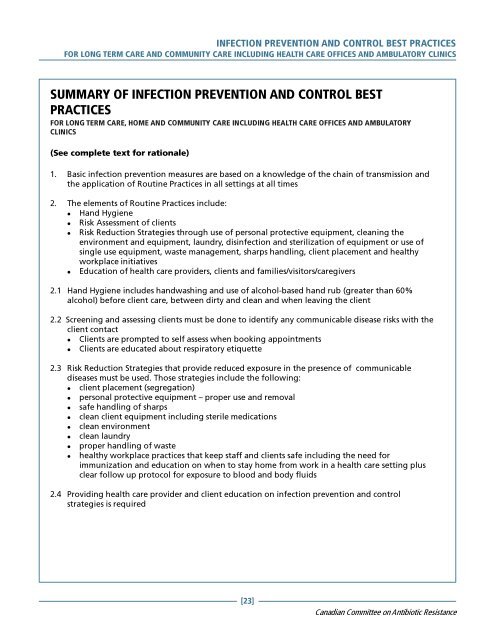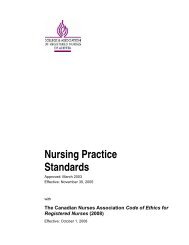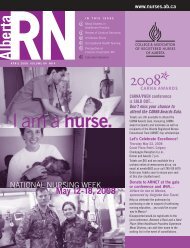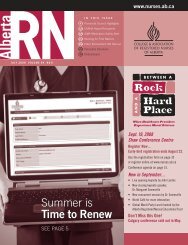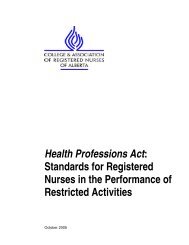Infection Prevention and Control Best Practices - College ...
Infection Prevention and Control Best Practices - College ...
Infection Prevention and Control Best Practices - College ...
Create successful ePaper yourself
Turn your PDF publications into a flip-book with our unique Google optimized e-Paper software.
INFECTION PREVENTION AND CONTROL BEST PRACTICES<br />
FOR LONG TERM CARE AND COMMUNITY CARE INCLUDING HEALTH CARE OFFICES AND AMBULATORY CLINICS<br />
SUMMARY OF INFECTION PREVENTION AND CONTROL BEST<br />
PRACTICES<br />
FOR LONG TERM CARE, HOME AND COMMUNITY CARE INCLUDING HEALTH CARE OFFICES AND AMBULATORY<br />
CLINICS<br />
(See complete text for rationale)<br />
1. Basic infection prevention measures are based on a knowledge of the chain of transmission <strong>and</strong><br />
the application of Routine <strong>Practices</strong> in all settings at all times<br />
2. The elements of Routine <strong>Practices</strong> include:<br />
� H<strong>and</strong> Hygiene<br />
� Risk Assessment of clients<br />
� Risk Reduction Strategies through use of personal protective equipment, cleaning the<br />
environment <strong>and</strong> equipment, laundry, disinfection <strong>and</strong> sterilization of equipment or use of<br />
single use equipment, waste management, sharps h<strong>and</strong>ling, client placement <strong>and</strong> healthy<br />
workplace initiatives<br />
� Education of health care providers, clients <strong>and</strong> families/visitors/caregivers<br />
2.1 H<strong>and</strong> Hygiene includes h<strong>and</strong>washing <strong>and</strong> use of alcohol-based h<strong>and</strong> rub (greater than 60%<br />
alcohol) before client care, between dirty <strong>and</strong> clean <strong>and</strong> when leaving the client<br />
2.2 Screening <strong>and</strong> assessing clients must be done to identify any communicable disease risks with the<br />
client contact<br />
� Clients are prompted to self assess when booking appointments<br />
� Clients are educated about respiratory etiquette<br />
2.3 Risk Reduction Strategies that provide reduced exposure in the presence of communicable<br />
diseases must be used. Those strategies include the following:<br />
� client placement (segregation)<br />
� personal protective equipment – proper use <strong>and</strong> removal<br />
� safe h<strong>and</strong>ling of sharps<br />
� clean client equipment including sterile medications<br />
� clean environment<br />
� clean laundry<br />
� proper h<strong>and</strong>ling of waste<br />
� healthy workplace practices that keep staff <strong>and</strong> clients safe including the need for<br />
immunization <strong>and</strong> education on when to stay home from work in a health care setting plus<br />
clear follow up protocol for exposure to blood <strong>and</strong> body fluids<br />
2.4 Providing health care provider <strong>and</strong> client education on infection prevention <strong>and</strong> control<br />
strategies is required<br />
[23]<br />
Canadian Committee on Antibiotic Resistance


